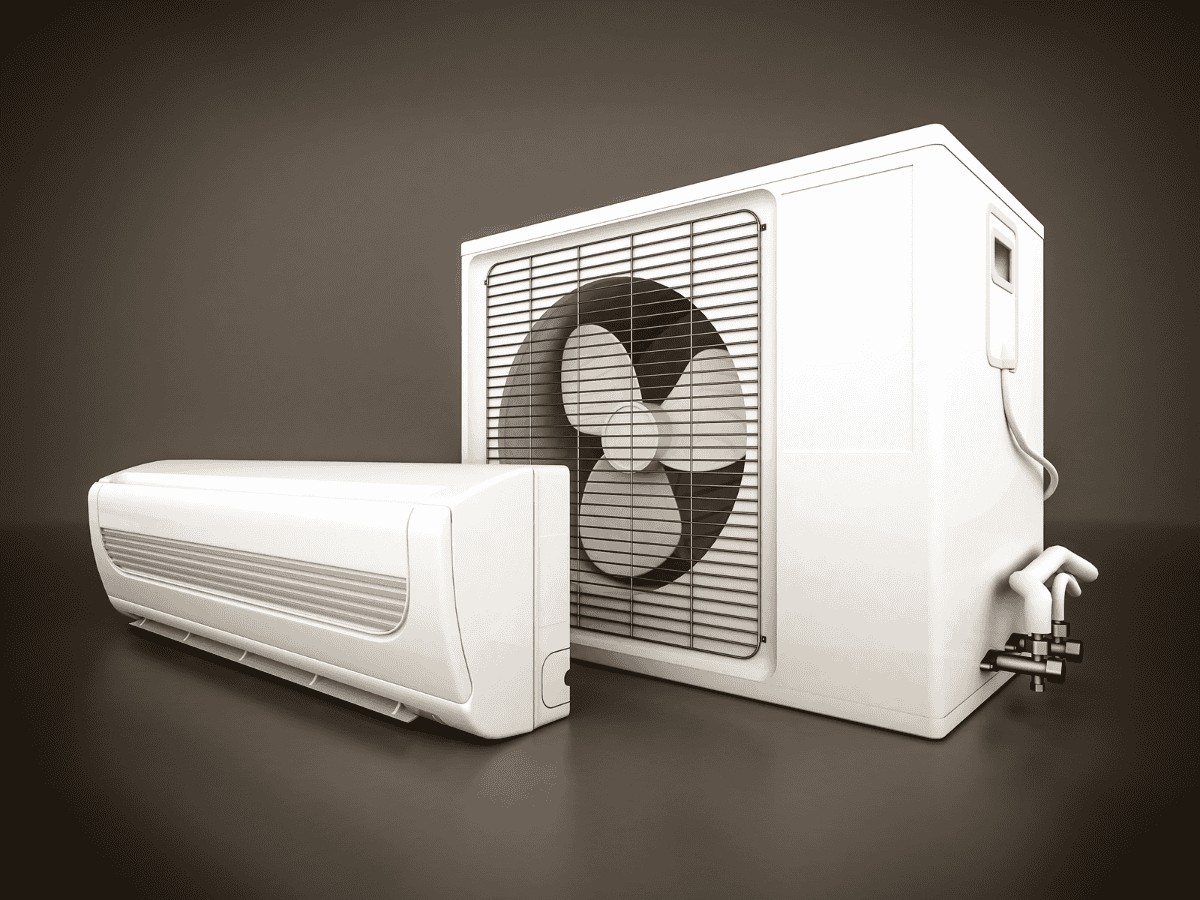Trying to decide between a mini split and a central air system for your home? You’re not alone—and we get it.
In Arizona’s intense heat, choosing the right cooling solution is more than a comfort upgrade—it’s an investment in your home’s efficiency and livability. Whether you’re replacing an outdated HVAC system or planning a brand-new install of an air conditioning system, understanding the key differences between mini split vs central air can help you make a smart, long-term decision.
This guide explains how each system works, its advantages, and which setup might best fit your home, budget, and lifestyle.
How Each System Works
Central AC and ductless mini-split systems cool your home by using a refrigerant line to pull heat from inside and release it outside. But they deliver that comfort in very different ways.
Central Air Conditioning:
- Uses one central indoor unit connected to a ducted system.
- Cooled air is pushed through ducts into various rooms via vents.
- Controlled by a single thermostat, ideal for uniform, whole-house cooling.
Mini Split (Ductless) System:
- Comprises one outdoor unit and one or more mini-split units placed in specific individual rooms or zones.
- Each indoor unit has its own temperature control, offering zoning benefits.
- No ductwork required, which simplifies installation and reduces energy loss.
Key Differences Between Mini Split and Central Air Systems
When deciding between a mini split and central air system, it’s essential to understand how they differ in terms of installation, energy efficiency, control, aesthetics, and more. Here’s a detailed breakdown to guide your choice:
1. Installation Requirements
Ductless mini-split systems are ductless, as the name suggests, meaning no existing ductwork is needed. The setup is relatively quick and minimally invasive—just a small hole is needed to connect the indoor and outdoor units. This makes them ideal for older homes, room additions, or spaces where ductwork isn’t practical.
On the other hand, central air conditioning systems depend on a network of ducts to distribute air throughout your home. If your house already has ductwork, installing central air may be straightforward. But if you don’t, the installation cost can rise significantly due to the complexity of adding ducts.
2. Energy Efficiency
In general, mini splits are more energy-efficient than central air systems. Since they operate on a zone-by-zone basis, they cool only the rooms in use, using less energy, which cuts down on energy waste. Plus, there’s no risk of energy loss through leaky ducts—a common issue with central systems.
Central AC units tend to consume more power, especially if the existing ductwork is old or poorly maintained. While high-SEER rated models are available, they still usually fall short of efficiency levels, leading to higher utility bills.
3. Comfort and Temperature Control
A big difference between the mini split and the central air debate is how each system handles comfort.
Mini-split units shine when it comes to personalized comfort. Each indoor unit operates independently, allowing you to set a unique temperature in every room. This multi-zone flexibility is perfect for families with varying comfort needs or rooms with different cooling demands.
Central AC systems cool the entire house uniformly using a single thermostat. While this provides consistent whole-home comfort, it lacks the flexibility of targeted temperature control. If one person runs hot and another runs cold, there’s less room for compromise.
4. Aesthetic and Design Considerations
One potential drawback of mini splits is that the indoor units are visible. These wall-mounted or ceiling-mounted units can be noticeable and may not blend well with specific interior designs. However, their modern, sleek designs are becoming more adaptable to different aesthetics.
Central air systems, by contrast, are completely hidden behind walls, floors, or ceilings—only the vents are visible. If maintaining a seamless look throughout your home is a priority, this system has the edge in terms of visual appeal.
5. Air Quality and Filtration
When it comes to air filtration, central air systems often have the upper hand. They use centralized filters that can trap dust, allergens, and other airborne particles before distributing the air through your home. Some systems also allow upgrades like HEPA filters or UV purification.
Mini splits do include filters in each indoor unit, but these are usually more basic and require frequent cleaning. If indoor air quality is a major concern, especially for allergy sufferers, central air may provide a better solution.
6. Initial Costs and Long-Term Investment
Mini splits usually have a higher upfront cost per unit, especially if you need multiple indoor units. However, they’re easier to install—especially in homes without ductwork—saving you money on labor and simplifying the overall AC installation process.
Central air systems may be more affordable per square foot if your home already has ducts. But installing or repairing ductwork can drive up the overall cost.
In the long run, mini splits offer greater energy efficiency, which can lower your monthly energy bills and provide a solid return on investment. Central air delivers better value for whole-home cooling when ducts are already in place and well-maintained.
Don’t forget—certain rebates may be available for high-efficiency cooling systems, which can help offset costs for both types of cooling setups.
Pros and Cons of Mini Split Systems
Like any cooling system, mini splits come with their own set of strengths and limitations. Here’s a quick overview to help you understand what to expect:
Pros:
- Easy Installation: No need to tear up walls for ducts.
- Energy Savings: Heat or cool only the rooms you’re using.
- Zoned Comfort: Personalized temperatures in every room.
- Quiet Operation: Indoor units run whisper-quiet.
- Ideal for Older Homes: Great when ducts aren’t an option.
Cons:
- Higher Upfront Cost: Can be expensive if outfitting an entire home.
- Visible Units: Indoor components are visible in each room.
- Basic Air Filtration: Not as effective as centralized systems for air quality control.
Pros and Cons of Central Air Systems
Central air conditioning is a classic choice for whole-home comfort—but it’s not without its trade-offs. Here’s a quick look at the key advantages and disadvantages to consider:
Pros:
- Invisible Comfort: No visible units—just vents.
- Efficient for Whole-Home Cooling: Great for homes with existing ducts.
- Better Air Filtration: Centralized filters help with allergies and indoor air quality.
- Single Thermostat Control: Adjust your entire home’s temperature with one device.
Cons:
- Requires Ductwork: Expensive and messy to install if you don’t already have it.
- Energy Loss: Airflow through ducts can leak, making the system less efficient.
- Less Flexibility: One temperature for the whole house.
Looking deeper into the advantages and disadvantages of mini-split systems can help you determine if they’re the right match for your space, especially if you’re evaluating long-term savings, comfort control, and installation ease.
Which System Is Right for You?
Every home is unique, and the right choice depends on your layout, budget, and comfort preferences.
Choose central air if:
- You already have ducts in place.
- You want consistent whole-house cooling.
- You prefer a less visible system.
Choose a mini split if:
- Your home doesn’t have ductwork.
- You want to cool only specific rooms or zones.
- You prioritize energy efficiency and flexible control.
Let River Valley Help You Decide
There’s no one-size-fits-all solution when it comes to choosing between mini split vs central air. It all comes down to what works best for your home, budget, and lifestyle.
Still unsure which system fits your needs? At River Valley Air Conditioning, we’ve helped countless homeowners in Arizona make the right choice for their space. We evaluate your home’s structure, energy needs, and preferences to offer personalized recommendations.
Contact our team for a no-pressure consultation. We’ll evaluate your home, compare options, and recommend the best system for your comfort and budget—backed by years of trusted service.
Schedule your free consultation now and stay cool with confidence.

